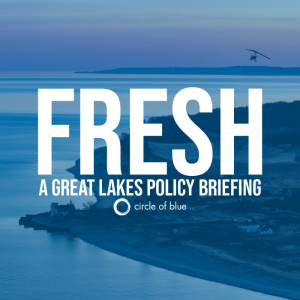Federal Water Tap, August 21: Smaller Colorado River Cuts in 2024 Operating Plan
The Rundown
- Thanks to a wet winter, Colorado River states, for now, see smaller cuts to water allocations.
- The first batch of EPA-mandated utility testing data shows the breadth of PFAS in drinking water.
- EPA denies a petition to strengthen water pollution requirements for large animal feeding operations.
- EPA adds PFAS and coal ash as enforcement priorities for the next four years.
- EPA removes three groundwater contamination sites from the Superfund list.
- The federal government sues a California mobile home park operator for drinking water violations.
- The GAO reports that a public health emergency fund has not had any congressional funding for the last 30 years and is too small to be useful.
And lastly, the Defense Department plans to clean up PFAS contamination from a closed Air Force base in northern Michigan.
“I welcome this action to prevent the spread of these toxic chemicals, but there is no question more must be done — and the Air Force must expedite cleanup efforts to protect public health and ensure access to clean drinking water in Oscoda.” — Sen. Gary Peters (D-MI) responding to the Defense Department’s announcement that it would install additional groundwater treatment systems at the former Wurtsmith Air Force Base, in northern Michigan. PFAS contamination from the base has shaken the town of Oscoda, where residents have been advised not to drink their water or eat fish.
In context: Fear and Fury in Michigan Town Where Air Force Contaminated Water
By the Numbers
3: Groundwater contamination sites that have been cleaned up and will be removed from the federal Superfund list. The sites are: Fort Hartford Coal Company Stone Quarry (Kentucky), Haviland Complex (New York), and Smithtown (New York).
$57,000: Approximate balance in June 2023 of a reserve fund to allow the Department of Health and Human Services to respond to public health emergencies. Established by Congress in 1983, the fund has not had any appropriations in the last 30 years, the Government Accountability Office reports. The fund can be tapped after floods, hurricanes, disease outbreaks, or other health emergencies. The current balance is “not enough to be useful,” former agency officials told the GAO.
News Briefs
Colorado River Operations in 2024
Due to wet weather and conservation the short-term outlook for the Colorado River is not as dire as a year ago.
That improvement is reflected in the interim guidelines for how the river’s two big reservoirs will be operated in 2024. The basin will be in a Tier 1 shortage, which is less severe than the Tier 2 shortage this year.
Under the guidelines, Lake Powell will release 7.48 million acre-feet next year – that’s on the low end of what is allowed. It means Lake Mead, located downstream, is projected to decline over the course of the year.
The guidelines could be short-lived. They’ll be in effect until the Bureau of Reclamation finishes evaluating a proposal that would result in voluntary conservation by Arizona, California, and Nevada of 3 million acre-feet of water through 2026 — as long as most of those conserving water get paid for their sacrifice.
Combined, lakes Mead and Powell are 36 percent full. Low, but still better than this time last year.
EPA Denies Petition to Strengthen CAFO Regulation
The EPA denied a petition to strengthen water pollution requirements for concentrated animal feeding operations, or CAFOs.
An EPA spokesperson told Circle of Blue that the agency will conduct a “comprehensive evaluation” of the CAFO program, including waste guidelines. The agency will also establish an advisory committee of local, state, industry, and environmental representatives to discuss the issues raised in the petition.
“A comprehensive evaluation is essential before determining whether any regulatory revisions are necessary or appropriate. EPA is committed to working with stakeholders, advocates, communities, and industry to explore how to achieve water quality improvements related to CAFOs,” the EPA said in a statement.
Filed by dozens of public interest groups, the petition sought to update Clean Water Act requirements for facilities that can house thousands of pigs, chickens, or cattle.
The desired changes include revising the agricultural stormwater exemption, ensuring that CAFOs have pollution permits, and requiring water quality monitoring.
The agency last revised CAFO pollution rules in 2008.
Drinking Water Violations
The Department of Justice sued the operator of a mobile home park located on tribal land in Southern California for failure to provide clean drinking water.
The lawsuit alleges that Oasis Mobile Home Park, home to more than 1,000 people, provides water that exceeds federal standards for arsenic. The EPA initially ordered the park to fix the problem in 2019.
The suit also alleges that the park mishandled its wastewater disposal system.
The park is located within the Torres Martinez Desert Cahuilla Indian Reservation
Studies and Reports
New Data on PFAS in Drinking Water
In the first batch of data from a nationwide drinking water testing program, about 8 percent of public water systems reported levels of PFOA, PFOS, or both above the federal health guideline.
The two most-studied PFAS compounds were among 29 PFAS in the testing program. Lithium was also included, and 22 percent of water systems showed levels above a non-regulatory health guideline.
The data are part of a federal program that requires utilities to monitor unregulated contaminants. The results inform future regulations.
Many more data points will follow. This first batch is only 7 percent of what will be submitted over the next three years.
For more information on the Unregulated Contaminant Monitoring Rule, click here.
Audits for State Revolving Funds
The EPA Office of the Inspector General says the EPA erred when it issued guidance that did not require states to review audits of water utilities that receive federal dollars through two infrastructure loan funds.
The watchdog’s report says the audits are an important tool for preventing fraud and waste. Billions of dollars flow through the state revolving funds to water utilities nationwide.
On the Radar
EPA Enforcement Priorities
The EPA announced six focus areas for enforcing environmental laws in the next four years.
The priorities include reducing greenhouse gas emissions, reduce PFAS exposure, address coal ash pollution, and ensure compliance with federal drinking water standards.
Other focus areas are air pollution and safety at facilities that handle hazardous chemicals.
Sewer System Repairs for Jackson, Mississippi
The EPA will hold public meetings on August 21-22 in Jackson, Mississippi, to discuss a remediation plan for the city’s malfunctioning sewer system.
Under a federal court order, a third-party manager will oversee the repairs.
Federal Water Tap is a weekly digest spotting trends in U.S. government water policy. To get more water news, follow Circle of Blue on Twitter and sign up for our newsletter.
Brett writes about agriculture, energy, infrastructure, and the politics and economics of water in the United States. He also writes the Federal Water Tap, Circle of Blue’s weekly digest of U.S. government water news. He is the winner of two Society of Environmental Journalists reporting awards, one of the top honors in American environmental journalism: first place for explanatory reporting for a series on septic system pollution in the United States(2016) and third place for beat reporting in a small market (2014). He received the Sierra Club’s Distinguished Service Award in 2018. Brett lives in Seattle, where he hikes the mountains and bakes pies. Contact Brett Walton






Leave a Reply
Want to join the discussion?Feel free to contribute!